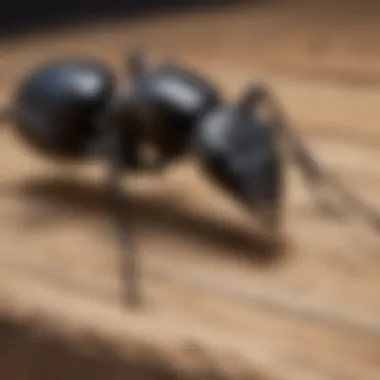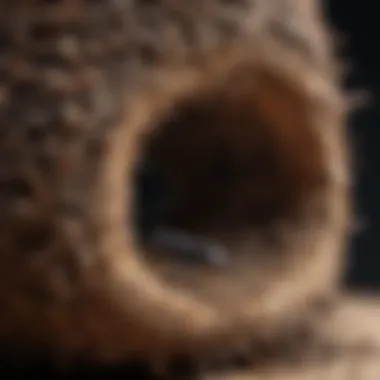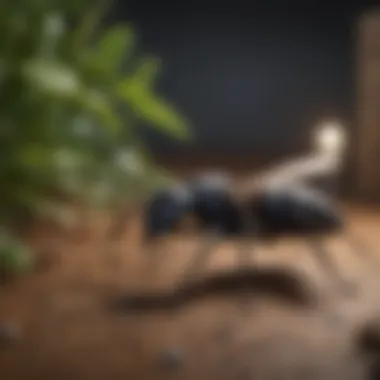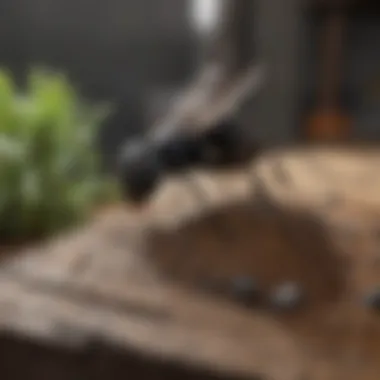Black Carpenter Ant Poison: Control & Prevention Strategies


Intro
Managing black carpenter ant infestations is a critical subject for homeowners. The presence of these pests can lead to significant structural damage as they tunnel through wood. Thus, understanding their biology and effective control measures becomes paramount. This article will explore various poison formulations available for the eradication of black carpenter ants. We will also discuss prevention strategies and the importance of environmentally responsible methods.
Biology of Black Carpenter Ants
Black carpenter ants are large and typically black in color. They are often confused with other ant species due to their size. Understanding their biology helps in effective management.
- Habitat: They usually nest in wood, particularly damp or decaying wood.
- Diet: Their diet mainly includes proteins and sugars, which make homes an attractive source.
- Reproductive Habits: Ant colonies can grow large, causing widespread infestations when conditions are favorable.
This unique biology necessitates a targeted approach in the use of poisons.
Poison Formulations
The market offers various poison options for treating black carpenter ants. Each formulation has distinct advantages and uses, making it crucial to choose wisely.
Baiting Systems
Baits contain attractants that lure ants to poison. They take the bait back to their colonies, effectively killing off the entire nest.
- Advantages:
- Targeted approach reduces the risk to non-target species.
- Slow-acting poison ensures the spread throughout the colony.
Contact Sprays
These poisons kill on contact, but they may not reach the nest. They are useful as a quick control method when infestations are light.
- Effectiveness: High, but risk of rein festation if the nest is not destroyed.
Best Practices for Prevention
Preventing an infestation is crucial. Here are some tips:
- Seal Cracks and Crevices: This reduces entry points.
- Maintain Dryness: Fix leaks and remove damp wood sources.
- Regular Inspections: Early detection can save significant cost and effort.
Taking these steps creates a less hospitable environment for carpenter ants.
Environmental Considerations
With growing awareness of pest control methods, selecting eco-friendly products is advisable. Responsible pest management strategies minimize harm to non-target organisms and ecosystems. Always follow guidelines when using chemical treatments.
"Effective pest management requires understanding both the target pest and the environment in which it exists."
Epilogue
Foreword to Black Carpenter Ants
Understanding black carpenter ants is crucial for property owners and pest control professionals alike. These ants are not just simple nuisances; they can cause structural damage that may not be immediately visible. Their ability to excavate wood leads to degradation of essential supports in buildings. This article sheds light on their biology, behavior, and control strategies, which form the foundation of effective management.
Biological Overview
Black carpenter ants (Camponotus spp.) are notable for their size, typically measuring between 1/4 inch to 1/2 inch long. They exhibit a distinct black coloration but may also appear with reddish or yellowish hues depending on the species. These ants possess a segmented body with a constriction between the thorax and abdomen, a key feature for identification. They are nocturnal foragers, using chemical trails to communicate with colony members. These aspects of their biology make it essential to understand their behavior for effective control.
Ecological Role
In the ecosystem, black carpenter ants fulfill various roles. They are scavengers that help break down decaying material, contributing to soil health. Their foraging activities may also aid in plant pollination, indirectly supporting ecological balance. However, when their nesting behavior intrudes upon human habitats, this ecological benefit is overshadowed by the potential for structural damage and infestations.
Importance in Pest Management
The management of black carpenter ants is vital to prevent significant property damage. Ignoring their presence can lead to expensive repairs due to weakened structures. Early detection and intervention are crucial, as their colonies can become well-established and difficult to eradicate. Understanding their nesting and foraging patterns helps in developing targeted strategies for control. Integrated pest management approaches, which combine chemical and non-chemical methods, are recommended to minimize negative effects on non-target species and the environment.


"Effective pest management requires knowledge. Understanding the biology and behavior of black carpenter ants is the first step towards control."
Identifying an Infestation
Identifying an infestation of black carpenter ants is crucial for effective management and eradication. Early detection can save homeowners significant time and economic resources. Understanding how to recognize these insects ensures a prompt response when faced with a potential invasion. There are several specific elements of identifying carpenter ants, including knowing their physical characteristics, signs of their activity, and indicators of potential damage they cause. This understanding not only aids in pinpointing existing issues but also informs prevention strategies against future infestations.
Physical Characteristics
To identify black carpenter ants, one must familiarize oneself with their distinctive physical traits. Mature black carpenter ants generally range from 1/4 inch to 1/2 inch in length. They exhibit a black-colored exoskeleton, with a smooth, shiny appearance. The body is divided into three segments: head, thorax, and abdomen. Unlike termites, carpenter ants have a narrow waist, which is a helpful distinguishing feature. Additionally, their mandibles are strong, used for excavating wood, creating a key factor in recognizing their damage.
Signs of Activity
Activity signs of black carpenter ants are numerous and telling. Here are some indicators:
- Foraging Trails: Workers often form trails when foraging for food. If you see a line of ants moving consistently, there might be an active nest nearby.
- Frass: This is a combination of wood shavings, dead ants, and other debris, typically found near nesting sites. Finding frass is a clear sign of carpenter ant activity.
- Noises: In quiet moments, you might hear a faint rustling sound, indicating their movement within the walls, especially at night.
Potential Damage Indicators
Black carpenter ants can cause significant damage to wooden structures. It is essential to look for the following potential damage indicators:
- Hollow Sounding Wood: Tapping on wood can produce a hollow sound, suggesting that the interior has been hollowed out by these ants.
- Wood Shavings: Piles of wood shavings can often be found at the base of infested structures, indicating active excavation.
- Structural Compromise: Over time, infested wood can weaken the integrity of structures, leading to sagging or shifting.
Recognizing these signs early can aid in swift action, which is paramount in controlling black carpenter ant populations and minimizing damage.
In summary, understanding how to identify an infestation of black carpenter ants is the first step to implementing effective control measures. Awareness of physical characteristics, activity signs, and damage indicators can empower homeowners and property managers in their quest to manage these pests effectively.
Understanding Black Carpenter Ant Behavior
Understanding the behavior of black carpenter ants is crucial for effective pest management. Knowledge about their habits, colony structure, and nesting preferences can significantly improve control strategies. Recognizing their behavior is not just about identifying how to eliminate them; it also helps homeowners formulate preventive measures. This section will discuss three key aspects: colony structure and dynamics, foraging patterns, and nest locations.
Colony Structure and Dynamics
Black carpenter ant colonies are intriguing social structures. These colonies consist of various castes, including workers, soldiers, and reproductive individuals. The queen is central to the colony, responsible for reproduction. Worker ants handle most of the tasks such as foraging, caring for the young, and maintaining the nest. Understanding this hierarchy offers valuable insights into how infestations might expand. The dynamics within a colony can shift based on environmental factors or food availability. Recognizing these factors can help identify potential targeting points for eradication efforts.
Foraging Patterns
Foraging behavior is critical in understanding how black carpenter ants seek food and water. Typically, they are nocturnal, actively searching during the night. Their foraging routes can often be traced back to the nest, making it easier to identify the source of infestation. They primarily feed on proteins and sugars, which play a significant role in their attraction to human spaces. By monitoring these patterns, homeowners can implement baiting techniques more effectively, enhancing the chances of eradication.
Nest Locations
Nest locations of black carpenter ants can vary greatly. They tend to prefer damp, decaying wood as well as hidden spaces within structures. Common sites include wall cavities, beneath floors, or inside wooden beams. Understanding their nesting preferences aids in prevention measures. Homeowners can conduct thorough inspections to find and eliminate ideal nesting areas before an infestation develops. Proper sealing of vents and entry points can significantly reduce potential nesting sites.
Understanding the behavior of black carpenter ants enhances the effectiveness of both control measures and preventive strategies.
Types of Black Carpenter Ant Poisons
Understanding the various poisons available for controlling black carpenter ant infestations is fundamental for effective pest management. This section explores the types of poisons, their chemical compositions, active ingredients, and the specific modes of action that make them suitable for treating these pests. Selecting the right type of poison involves careful consideration of their effectiveness, safety, and environmental impact.
Chemical Composition and Types
Black carpenter ant poisons come in different formulations, each tailored to target the unique biology of the ants. Common types include bait systems, sprays, and dusts.
- Bait systems attract ants, allowing them to consume a toxic substance before it’s taken back to the nest. This ensures that poison is spread within the colony, promoting a more effective eradication process.
- Sprays are designed to provide immediate contact kill and can be effective in treating visible infestations. They often contain a combination of chemical agents that can deter and eliminate ants on contact.
- Dust formulations are useful in inaccessible areas, allowing the poison to remain effective for longer periods, especially in high-moisture environments.
In selecting a product, one must also consider the excipients or inactive ingredients within these formulations that may affect effectiveness and safety.
Active Ingredients
The active ingredients in black carpenter ant poisons play a critical role in their function. These compounds determine the product's efficacy and can vary across different formulations. Some prevalent active ingredients include:
- Hydramethylnon: This ingredient disrupts energy production in ants, leading to death.
- Fipronil: This acts on the central nervous system of ants, causing paralysis and eventual death.
- Boric acid: Commonly used in bait formulations, it affects the digestive system, causing ants to die slowly and spread the poison to other colony members.


Understanding these ingredients can aid homeowners in selecting the right type of poison that aligns with their specific infestation issues.
Modes of Action
Different poisons operate through various modes of action. Each mode can significantly impact both the speed and extent of ant control. Here are the primary modes:
- Ingestion: Ants consume bait containing toxic ingredients, which then affects their internal systems leading to death. This is effective for colony elimination since treated ants carry the poison back to the nest.
- Contact: Sprays work by directly interacting with the ants when applied to surfaces. Once the ants come into contact with treated areas, the chemicals affect their physiology and lead to fatal consequences.
- Repellence: Some products may include repellent features to discourage ants from entering specific areas, reducing the likelihood of reinfestation after cleaning up an infestation.
Understanding these modes of action allows for strategic application, ensuring that chosen poisons are utilized correctly and responsibly,
Choosing the right type of black carpenter ant poison is essential to ensuring effective management and minimizing potential harm to the environment and human health.
By comprehensively addressing the different types of black carpenter ant poisons, their active ingredients, and modes of action, readers become more equipped to make informed decisions for effective pest control.
Application Methods for Black Carpenter Ant Poison
Understanding how to effectively apply poison is crucial in managing black carpenter ant infestations. Different application methods can influence the success of pest control efforts. Each method comes with its own set of benefits and considerations that can directly impact the effectiveness of eradication efforts. A well-timed and methodical approach ensures that poison reaches the intended target while minimizing risks to the environment and non-target species.
Baiting Techniques
Baiting techniques are among the most effective methods for managing black carpenter ants. This approach allows for targeted poison delivery, as the ants carry the poison back to their colonies, which can eliminate the entire hive. It is important to use the right bait formulation because ants are selective feeders. You may choose liquid or solid baits based on your local conditions and ant behavior. The key is to place the bait in areas where ant activity is observed.
Advantages of baiting include:
- Effective colony-wide control: Ants share the bait, which helps to eliminate the entire colony.
- Reduced exposure: Baits minimize contact with non-target species.
- Sustained action: Some formulations work over time, providing longer-lasting control.
It’s essential to monitor bait stations regularly. If the bait is not consumed, relocation may be necessary. Additionally, keeping living spaces clean will ensure that ant activity persists around bait stations.
Sprays and Granules
Sprays and granules present a quick solution for immediate problems. Sprays can be applied directly to trails and nest sites, leading to rapid action. Granules can be spread around the perimeter of the home or in gardens where ants are present. Both forms have their distinct applications.
Some aspects to consider:
- Quick knockdown: Sprays can rapidly reduce visible populations.
- Barrier protection: Granules create a protective barrier, preventing reinfestation.
- Immediate results: Visible reduction in ant numbers can be seen soon after application.
Using these methods requires caution. It is important to follow the manufacturer's instructions to avoid pesticide drift and minimize risks to the environment.
Professional Pest Control Services
For persistent infestations, many homeowners may find it more beneficial to seek professional pest control services. Experts have access to a wider range of products and advanced application techniques. They can conduct comprehensive assessments of properties to determine the root causes of infestations.
Professionals bring several advantages:
- Expert assessment: They can identify nesting sites and activity levels more accurately.
- Customized solutions: Treatments can be tailored to specific environments and infestations.
- Integrated pest management: They often incorporate eco-friendly methods alongside chemical control, offering balanced solutions.
Engaging a pest control service typically leads to better long-term results. They also provide monitoring services, which can help track effectiveness and reduce chances of reinfestation.
Environmental Considerations
Understanding the environmental considerations surrounding the use of black carpenter ant poison is crucial for homeowners addressing infestations. This section will explore the multifaceted impacts of poison use, particularly on non-target species and human health. It is essential to recognize that pest control methods have far-reaching consequences, influencing not only the immediate environment but also the surrounding ecosystem and community health.
Impact on Non-target Species
The use of pesticides can significantly affect non-target species in the surrounding area. Black carpenter ant poisons may harm beneficial insects and other wildlife. When poisons enter the environment, they can affect bees, butterflies, and other insect pollinators critical for healthy ecosystems. Additionally, birds and mammals that feed on poisoned ants may experience secondary poisoning, disrupting their populations.
To minimize these risks, homeowners should consider targeted baiting methods and avoid broad-spectrum sprays. Using local pest control solutions can also lessen the impact on local flora and fauna.
"Be mindful of the ecological balance while managing pest problems; every action carries potential consequences."
Human Health Risks


Human health is another significant concern when implementing pest control measures. While black carpenter ants do not pose a direct threat, the poisons used to eliminate them often contain toxic substances. Accidental exposure can lead to health complications, especially for children and pets. Symptoms of exposure range from mild irritation to severe reactions, including respiratory problems or allergic responses.
It is vital to follow safety precautions when using pesticides. These may include wearing protective gear, ensuring proper ventilation, and keeping treated areas inaccessible to pets and children for specified periods. Understanding the labels and guidelines can help reduce risks associated with these products.
Integrating Eco-friendly Practices
To balance effective pest management with environmental integrity, integrating eco-friendly practices is essential. Homeowners can adopt several strategies to reduce their reliance on harsh chemicals. For instance, implementing physical barriers and natural repellents can decrease the likelihood of an infestation before it even starts. Methods such as diatomaceous earth or essential oil-based solutions can provide effective alternatives with less impact on both health and the environment.
Regular maintenance of property is also an effective preventive measure. This includes sealing cracks and crevices, reducing moisture accumulation, and proper waste management. Enhancing living conditions for beneficial insects contributes to a healthy backyard ecosystem that can naturally keep carpenter ant populations in check.
Preventive Measures Against Infestations
Preventing infestations of black carpenter ants is crucial for homeowners. These ants can cause serious structural damage to properties. Understanding how to deter them can save money and maintain safety. In this section, we will discuss various preventive measures, focusing on structural improvements, landscaping management, and regular monitoring.
Structural Improvements
Enhancing the structural integrity of a home is a fundamental step in preventing black carpenter ant infestations. Sealing gaps and cracks in walls, foundations, and near windows can minimize entry points. Pay special attention to areas where utilities enter the home. Use caulking to fill any gaps. This not only keeps ants and other pests out but can also contribute to energy efficiency.
Another important consideration is the maintenance of wood structures. Regularly inspect wood elements like beams and decks for signs of damage or decay. Replace any rotting wood immediately. Ants are attracted to moist or decayed wood, so keeping the structure dry is essential.
In addition, ensure that all vents and chimneys have screens. This prevents not just ants, but other pests from entering your living spaces.
Landscaping and Outdoor Management
Landscaping plays a vital role in pest prevention. Keeping a tidy yard can greatly reduce the chances of an infestation. First, avoid overhanging branches. Carpenter ants often nest in trees and can easily access homes through branches touching the roof.
Keeping mulch, firewood, and other wood products at least 20 feet away from the home also helps. These materials can serve as nesting sites for ants. Additionally, regular trimming of hedges and plants will prevent ants from finding shelter too close to the home.
Another key practice is to maintain gutters and downspouts. Ensure they are free of debris to prevent water accumulation. Wet areas are attractive to black carpenter ants as they seek moisture for their nests.
Regular Monitoring Techniques
Regular monitoring is essential for the early detection of pest problems. Homeowners should routinely check for signs of ant activity, especially during warmer months. Look for trails of ants, discarded wings, or small piles of wood shavings.
Consider setting up bait stations around areas prone to infestation for continuous monitoring. These stations can help to identify ant activity before it becomes a full-blown problem.
Additionally, maintaining a pest control log can be beneficial. Document sightings and any corresponding actions taken. This will help recognize patterns over time and provide insights for addressing potential infestations more effectively.
Regular monitoring helps catch issues early, making it easier to manage
Epilogue and Further Considerations
The section on conclusions within this article grounds the discussion on managing black carpenter ant infestations in practical reflections and advices. By synthesizing the various practices and techniques for pest control, this segment becomes vital in reinforcing strategies that homeowners and pest management professionals can adopt.
This is not solely about eradicating the ants but understanding a holistic approach that includes prevention and sustainable practices. It’s essential to acknowledge that awareness, knowledge, and strategic actions taken today contribute to longer-term solutions that minimizes recurrence of infestations.
Summary of Effective Practices
A comprehensive grasp of effective practices will enable proactive management of black carpenter ants. Here are key recommendations:
- Regular Inspections: Homeowners should schedule frequent checks of both indoor and outdoor spaces for signs of ants.
- Eliminate Food Sources: Proper food storage and cleaning practices can deter ant activity.
- Seal Entrances: Identifying and sealing potential entry points can significantly reduce invasions.
- Use Natural Deterrents: Implementing essential oils or diatomaceous earth can be effective without harsh chemicals.
By integrating these effective practices, homeowners stand a better chance of keeping the invasive black carpenter ants at bay.
Research and Technological Advances
The advancement in research and technology continues to shape pest management. Specific approaches to studying black carpenter ants include:
- Behavioral Studies: Research on foraging behaviors informs bait placement strategies.
- Chemical Development: Innovations in biopesticides aim at minimizing environmental impact while maintaining effectiveness.
- Smart Monitoring Systems: Technology facilitates real-time monitoring of pest activity, which integrates seamlessly with management strategies.
Such developments represent a significant shift toward more informed and precise pest control measures.
Long-term Solutions for Ant Management
Looking towards sustainable methods for ant management promotes a healthier living environment. Long-term strategies should encompass:
- Community Education: Increasing awareness about black carpenter ants through community workshops can empower families and neighborhoods.
- Integrated Pest Management: Adopting this multifaceted approach that combines cultural, physical, and chemical controls can yield better long-term success.
- Regular Maintenance: Continuously maintaining landscapes and structures reduces conditions conducive for ant infestations.
By employing these solutions, individuals create a resilient approach to managing black carpenter ants effectively.















